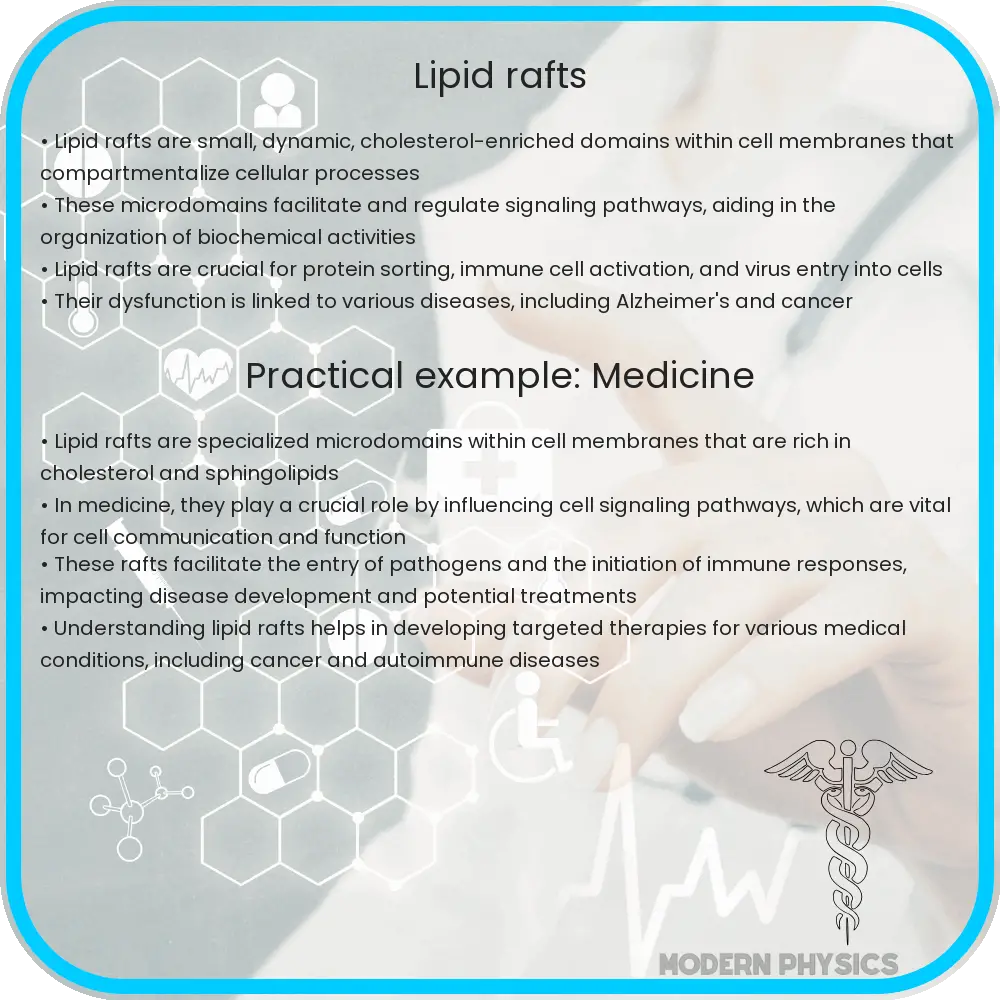Explore the role of lipid rafts in cell membrane structure, their impact on signaling and trafficking, and their significance in disease and potential therapies.

Lipid Rafts: Understanding Their Critical Role in Cellular Processes
Lipid rafts are specialized, dynamic microdomains within the cell membrane that play a pivotal role in various cellular processes. Comprising a distinct composition of sphingolipids, cholesterol, and specific proteins, these rafts are thought to organize the membrane for improved functionality and signaling. The unique makeup of lipid rafts makes them less fluid and more ordered than the surrounding membrane, allowing them to serve as platforms for cellular signaling and trafficking.
Structure and Composition
The structural integrity of lipid rafts is primarily due to their high concentration of sphingolipids and cholesterol. Sphingolipids, with their long and saturated acyl chains, together with cholesterol, which fits snugly between these chains, create a tightly packed and ordered lipid environment. This environment contrasts with the more fluid and disordered structure of the surrounding phospholipid bilayer. The specific lipid composition contributes to the raft’s characteristic buoyancy, enabling it to float within the fluid membrane.
Function in Cellular Signaling
Lipid rafts are critical in clustering signaling molecules, thereby facilitating cellular communication and signal transduction. By concentrating receptor molecules and their associated signaling proteins, rafts can amplify the signal received by a cell, leading to a more efficient and targeted response. This is particularly evident in the immune response, where lipid rafts gather receptors and signaling molecules to initiate T-cell activation.
Role in Endocytosis and Trafficking
Beyond signaling, lipid rafts are involved in the sorting and transport of proteins and lipids within the cell. They play a significant role in endocytosis, the process by which cells internalize substances from their environment. Lipid rafts can aggregate and form endocytic vesicles, directing the transport of their cargo to specific cellular locations. This mechanism is crucial for the proper distribution of membrane proteins and lipids, maintaining cellular homeostasis and function.
Dynamics and Mobility
The dynamic nature of lipid rafts is fundamental to their function. Their composition and size can change rapidly in response to cellular signals or changes in the environment, allowing cells to adapt quickly to new conditions. This fluidity enables the transient formation of signaling complexes, providing a temporal and spatial regulation of cellular processes.
Challenges in Studying Lipid Rafts
Despite their significance in cell biology, studying lipid rafts presents several challenges. Their small size, dynamic nature, and heterogeneity make them difficult to analyze with conventional biochemical methods. Advanced techniques such as fluorescence microscopy and single-molecule tracking are often required to observe these microdomains directly and understand their behavior in real-time. Furthermore, the transient assembly of lipid rafts complicates the study of their specific roles in cellular processes, requiring innovative experimental approaches to capture their fleeting existence.
Implications for Disease and Therapy
Lipid rafts have been implicated in the pathogenesis of various diseases, including Alzheimer’s disease, HIV infection, and cancer. The role of lipid rafts in facilitating the entry of viruses into cells and in modulating signal transduction pathways offers potential targets for therapeutic intervention. By disrupting or mimicking the function of lipid rafts, researchers are exploring new strategies for drug development and disease treatment. This includes the design of molecules that can specifically target lipid rafts to modulate their function, offering hope for novel therapies against diseases with significant lipid raft involvement.
Conclusion
Lipid rafts represent a fascinating aspect of cellular biology, embodying the complexity and dynamism of biological membranes. Their role in organizing cellular signaling, facilitating membrane trafficking, and their involvement in disease pathogenesis underscores their importance in cell function and health. Despite the challenges associated with studying these elusive microdomains, advances in technology and methodology continue to shed light on their mechanisms and functions. Understanding the intricate dynamics of lipid rafts holds the promise of uncovering new therapeutic targets, offering exciting possibilities for the treatment of diseases where lipid rafts play a critical role. As research continues to unravel the mysteries of lipid rafts, their study not only enriches our understanding of cell biology but also opens new avenues for medical innovation and drug discovery.
